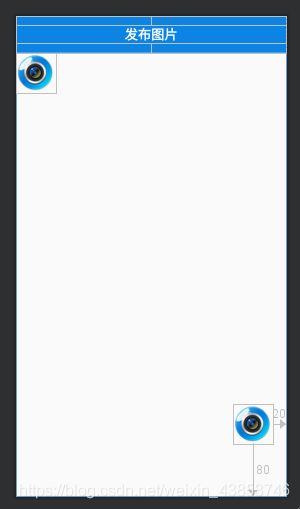【Android项目实战 | 从零开始写app(15)】实现图片发布模块 | 必知必会之调用系统相机拍照、相册一一解决android7 打开相机闪退奔溃问题
续更,这个系列即将完结了。本篇实现的是一个发布图片的功能案例,调用系统相机拍照、相册实现图片发布模块效果,本来想是实现服务端的贴子和图片DRUD操作发送,但后台接口没时间写,就改为这个简单的图片拍照显示,因为调用系统相机拍照,打开相册这些常规操作基本都是开发app中必知必会的,嗯,所以就这样~,我没话了。别听我废话了,直接看下面。
本篇效果
实现Intent隐式意图调用系统相机拍照、打开系统相册并进行图片的处理后实现图片数据的回传。其中用到了AlertDialog对话框,Intent等数据传递等基础知识点。
文章导航
一、【Android项目实战 | 从零开始写app(一)】 创建项目
二、【Android项目实战 | 从零开始写app(二)】实现闪屏页,启动app
三、【Android项目实战 | 从零开始写app(三)】实现引导页,进入登录or主页面
四、【Android项目实战 | 从零开始写app(四)】Okhttp+Gson实现服务端登录验证功能
五、【Android项目实战 | 从零开始写app(五)】okhttp+gson实现服务端注册功能
六、【Android项目实战 | 从零开始写app(六)】用TabLayout+ViewPager搭建App 框架主页面底部导航栏
七、【Android项目实战 | 从零开始写app(七)】优化主页导航栏,禁用主页页面滑动切换效果
八、【Android项目实战 | 从零开始写app(八)】实现app首页广告轮播图切换和搜索跳转
九、【Android项目实战 | 从零开始写app(九)】实现主页底部新闻模块数据的解析
十、【Android项目实战 | 从零开始写app(10)】Okhttp+glide+json+ListView实现新闻模块数据的填充显示
十一、【Android项目实战 | 从零开始写app(11)】实现app首页九宫格服务分类点击跳转
十二、【Android项目实战 | 从零开始写app(12)】实现app首页热门推荐
十三、【Android项目实战 | 从零开始写app(13)】实现服务页面数据的解析
十四、【Android项目实战 | 从零开始写app(14)】实现用户中心模块清除token退出登录&信息修改等功能
十五、【Android项目实战 | 从零开始写app(15)】实现图片发布模块 | 必知必会之调用系统相机拍照、相册
功能实现
首先,在AndroidManifest.xml清单文件中加入授权权限:
<uses-permission android:name="android.permission.CAMERA" />
<uses-permission android:name="android.permission.WRITE_EXTERNAL_STORAGE" />
TakePhotoActivity:
package com.example.myapp.activity;
import androidx.appcompat.app.AppCompatActivity;
import androidx.appcompat.widget.Toolbar;
import androidx.core.app.ActivityCompat;
import androidx.core.content.ContextCompat;
import android.Manifest;
import android.app.AlertDialog;
import android.content.ContentResolver;
import android.content.DialogInterface;
import android.content.Intent;
import android.content.pm.PackageManager;
import android.graphics.Bitmap;
import android.graphics.BitmapFactory;
import android.graphics.Canvas;
import android.graphics.Color;
import android.graphics.Matrix;
import android.graphics.Paint;
import android.graphics.PaintFlagsDrawFilter;
import android.graphics.Rect;
import android.net.Uri;
import android.os.Build;
import android.os.Bundle;
import android.os.StrictMode;
import android.provider.MediaStore;
import android.view.View;
import android.widget.Button;
import android.widget.ImageView;
import android.widget.TextView;
import android.widget.Toast;
import com.example.myapp.R;
import java.io.FileNotFoundException;
import java.io.IOException;
public class TakePhotoActivity extends AppCompatActivity {
private Button btn_photo;
private TextView tv;
private ImageView img;
private Toolbar toolbar;
Intent intent = null;
@Override
protected void onCreate(Bundle savedInstanceState) {
super.onCreate(savedInstanceState);
setContentView(R.layout.activity_take_photo);
toolbar = (Toolbar) findViewById(R.id.toolbar);
btn_photo = findViewById(R.id.btn_photo);
img = findViewById(R.id.img);
/**
* 解决android7调用照相机后直接奔溃问题
*/
if (Build.VERSION.SDK_INT >= Build.VERSION_CODES.N) {
StrictMode.VmPolicy.Builder builder = new StrictMode.VmPolicy.Builder();
StrictMode.setVmPolicy(builder.build());
builder.detectFileUriExposure();
}
checkPermission();
initListener();
}
/**
* 检查拍照权限,防止权限拒绝
*/
private void checkPermission() {
if (ContextCompat.checkSelfPermission(TakePhotoActivity.this, Manifest.permission.CAMERA) != PackageManager.PERMISSION_GRANTED) {
// 执行到这里表示没有访问权限
if (ActivityCompat.shouldShowRequestPermissionRationale(TakePhotoActivity.this, Manifest.permission.CAMERA)) {
Toast.makeText(TakePhotoActivity.this,"禁止访问",Toast.LENGTH_LONG).show();
} else {
ActivityCompat.requestPermissions(TakePhotoActivity.this, new String[]{
Manifest.permission.CAMERA}, 200);
}
} else {
takePhoto();
}
}
private void initListener() {
// 顶部返回
toolbar.setNavigationIcon(R.mipmap.top_bar_left_back);
toolbar.setNavigationOnClickListener(new View.OnClickListener() {
@Override
public void onClick(View view) {
finish();
}
});
// 按钮点击事件,单击弹出AlertDialog对话框
btn_photo.setOnClickListener(new View.OnClickListener() {
@Override
public void onClick(View v) {
new AlertDialog.Builder(TakePhotoActivity.this)
.setIcon(R.mipmap.picture)
.setMessage("插入图片")
.setPositiveButton("拍照", new DialogInterface.OnClickListener() {
@Override
public void onClick(DialogInterface dialog, int which) {
takePhoto();
}
}).setNegativeButton("相册", new DialogInterface.OnClickListener() {
@Override
public void onClick(DialogInterface dialog, int which) {
chooseFromAlbum();
}
}).create().show();
}
});
}
/**
* 获取图片
*/
public void takePhoto() {
intent = new Intent(MediaStore.ACTION_IMAGE_CAPTURE); // 调用系统相机
intent.setAction(MediaStore.ACTION_IMAGE_CAPTURE);
startActivityForResult(intent, 200); //有数据的返回
}
/**
* 选择相册
*/
public void chooseFromAlbum() {
intent = new Intent();
intent.setType("image/*"); //设定类型为image
intent.setAction(Intent.ACTION_GET_CONTENT);
startActivityForResult(intent, 100);//选中相片后返回本Activity
}
/**
* 重写onActivityResult方法:将返回的图片数据设置到ImageView上
*
* 参数说明:requestCode值:100 为打开系统相册选择相片,requestCode值:200为调用系统相机拍照
* @param requestCode
* @param resultCode
* @param data
*/
@Override
public void onActivityResult(int requestCode, int resultCode, Intent data) {
super.onActivityResult(requestCode, resultCode, data);
if (resultCode == RESULT_OK) {
Uri uri = data.getData(); //获取数据
ContentResolver contentResolver = getContentResolver();
Bitmap bitmap = null;
Bundle extras = null;
if (requestCode == 100) {
try {
bitmap = BitmapFactory.decodeStream(contentResolver.openInputStream(uri)); //将对象存入Bitmap中
} catch (FileNotFoundException e) {
e.printStackTrace();
}
}
if (requestCode == 200) {
try {
if (uri != null){
bitmap = MediaStore.Images.Media.getBitmap(contentResolver, uri); // 根据Uri获取Bitmap图片
} else{
// 从Bundle里面获取Bitmap图片
extras = data.getExtras();
bitmap = extras.getParcelable("data");
}
} catch (FileNotFoundException e) {
e.printStackTrace();
} catch (IOException e) {
e.printStackTrace();
}
}
int imgWidth = bitmap.getWidth(); //获取图片宽度
int imgHeight = bitmap.getHeight(); // 获取图片高度
double partion = imgWidth * 1.0 / imgHeight;
double sqrtLength = Math.sqrt(partion * partion + 1);
/**
* 设置图片新的缩略图大小
*/
double newImgW = 680 * (partion / sqrtLength);
double newImgH = 680 * (1 / sqrtLength);
float scaleW = (float) (newImgW / imgWidth);
float scaleH = (float) (newImgH / imgHeight);
Matrix mx = new Matrix();
/**
* 对原图片进行缩放
*/
mx.postScale(scaleW, scaleH);
bitmap = Bitmap.createBitmap(bitmap, 0, 0, imgWidth, imgHeight, mx, true);
bitmap = getBitmapWidth(bitmap);
img.setImageBitmap(bitmap);
}
}
/**
* 给图片加边框,并返回边框后的图片
* @param bitmap
* @return
*/
public Bitmap getBitmapWidth(Bitmap bitmap) {
float frameSize = 0.2f;
Matrix matrix = new Matrix();
// 用来做底图
Bitmap mbitmap = Bitmap.createBitmap(bitmap.getWidth(),bitmap.getHeight(), Bitmap.Config.ARGB_8888);
// 设置底图为画布
Canvas canvas = new Canvas(mbitmap);
canvas.setDrawFilter(new PaintFlagsDrawFilter(0, Paint.ANTI_ALIAS_FLAG | Paint.FILTER_BITMAP_FLAG));
float scale_x = (bitmap.getWidth() - 2 * frameSize - 2) * 1f / (bitmap.getWidth());
float scale_y = (bitmap.getHeight() - 2 * frameSize - 2) * 1f / (bitmap.getHeight());
matrix.reset();
matrix.postScale(scale_x, scale_y);
// 减去边框的大小
bitmap = Bitmap.createBitmap(bitmap, 0, 0, bitmap.getWidth(),bitmap.getHeight(), matrix, true);
Paint paint = new Paint();
paint.setColor(Color.WHITE);
paint.setStrokeWidth(1);
paint.setStyle(Paint.Style.FILL);
// 绘制底图边框
canvas.drawRect(new Rect(0, 0, mbitmap.getWidth(), mbitmap.getHeight()),paint);
// 绘制灰色边框
paint.setColor(Color.GRAY);
canvas.drawRect(new Rect((int) (frameSize), (int) (frameSize), mbitmap.getWidth() - (int) (frameSize), mbitmap.getHeight() - (int) (frameSize)), paint);
canvas.drawBitmap(bitmap, frameSize + 2, frameSize + 2, paint);
return mbitmap;
}
}
有一点要注意的是Android7及以上调用相机会出现闪退,可以通过StrictMode.VmPolicy.Builder来解决这个问题。
上面的checkPermission()是用来检查权限的,这是因为高版本的如果直接调用拍照会出现闪退奔溃,需要做权限处理:
private void checkPermission() {
if (ContextCompat.checkSelfPermission(TakePhotoActivity.this, Manifest.permission.CAMERA) != PackageManager.PERMISSION_GRANTED) {
// 执行到这里表示没有访问权限
if (ActivityCompat.shouldShowRequestPermissionRationale(TakePhotoActivity.this, Manifest.permission.CAMERA)) {
Toast.makeText(TakePhotoActivity.this,"禁止访问",Toast.LENGTH_LONG).show();
} else {
ActivityCompat.requestPermissions(TakePhotoActivity.this, new String[]{
Manifest.permission.CAMERA}, 200);
}
} else {
takePhoto();
}
}
activity_take_photo.xml
简单的页面布局,其他功能,页面想更好看的,可以自己是实现,我这里简单粗糙实现,勿吐槽哈。

<RelativeLayout
xmlns:android="http://schemas.android.com/apk/res/android" android:layout_width="match_parent"
android:orientation="vertical"
android:layout_height="match_parent">
<RelativeLayout
android:layout_width="match_parent"
android:id="@+id/re"
android:layout_height="wrap_content">
<androidx.appcompat.widget.Toolbar
android:layout_width="match_parent"
android:layout_height="wrap_content"
android:id="@+id/toolbar"
android:background="#0B84E4"/>
<TextView
android:layout_width="match_parent"
android:layout_height="wrap_content"
android:text="发布图片"
android:textColor="#fff"
android:id="@+id/service_name"
android:textStyle="bold"
android:textSize="20sp"
android:gravity="center"
android:layout_centerVertical="true"/>
RelativeLayout>
<ImageView
android:layout_width="wrap_content"
android:layout_height="wrap_content"
android:layout_below="@id/re"
android:src="@mipmap/photo"
android:id="@+id/img"/>
<Button
android:layout_width="60dp"
android:layout_height="60dp"
android:id="@+id/btn_photo"
android:layout_alignParentBottom="true"
android:layout_alignParentRight="true"
android:layout_marginBottom="80dp"
android:layout_marginRight="20dp"
android:background="@mipmap/photo" />
RelativeLayout>
这里用到一个控件:Toolbar,UI主题用的是NoActionBar,这个设计新版本的Material Desgin布局和设计知识,感兴趣的自己查阅相关文档~
<resources>
<style name="AppTheme" parent="Theme.AppCompat.Light.NoActionBar">
- "colorPrimary"
>@color/colorPrimary
- "colorPrimaryDark">@color/colorPrimaryDark
- "colorAccent">@color/colorAccent
style>
<style name="TextStyle">
- "android:layout_width"
>wrap_content
- "android:layout_height"
>wrap_content
- "android:drawablePadding">10dp
- "android:gravity">center
- "android:padding">10dp
- "android:textColor">#5d5d5d
style>
resources>
